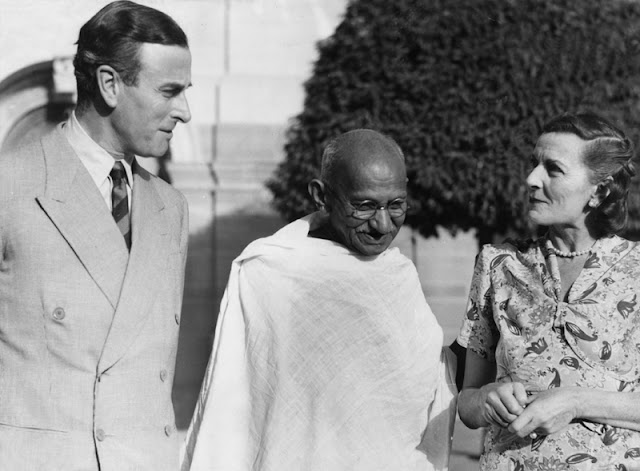 |
| The Earl and Countess Mountbatten of Burma with Mahatma Gandhi. Image: Wikimedia Commons |
Edwina Cynthia Annette Ashley was born on November 28, 1900 in Broadlands, Romsey Extra, Hampshire, England. She was the elder daughter of Wilfred William Ashley, later 1st Baron Mount Temple, and his first wife Amalia Mary Maud Cassel, whose father Sir Ernest Joseph Cassel was an international magnate considered to be one of the wealthiest and most powerful men in Europe at the time.
Childhood
Edwina was sent away to boarding schools—first to Eastbourne’s Links then to Suffolk’s Alde House—after her father remarried in 1914. Seeing his granddaughter’s unwillingness in neither of the institutions, Sir Ernest Joseph Cassel invited Edwina to live with her. She eventually acted as hostess at his London residence, Brook House, as well as at his other mansions, Moulton Paddocks and Branksome Dene. From him she inherited a considerable fortune--£ 2 million, as well, as the lush Brook House after Sir Ernest’s death in 1921.
Marriage and Family
Edwina, then a leading member of London society, married naval officer Lord Louis Mountbatten on July 18, 1922 at St. Margaret’s Church in London, England. Eight thousand people—including Queen Mary, Queen Alexandra, and the future King Edward VIII—attended the occasion dubbed as “wedding of the year”. The reception took place at the lavish Brook House, after which the couple made their way to the bride’s family country house via a Rolls-Royce Silver Ghost. After her wedding, she was known as Lady Louis Mountbatten. The union produced two children: Patricia, 2nd Countess Mountbatten of Burma (1924-2017), who was born on February 14, 1924, and Pamela, born on April 19, 1926.
 |
| Lord and Lady Louis Mountbatten. Image from Wikimedia Commons |
Known to be wildly promiscuous, Lady Louis Mountbatten figured in numerous acts of indiscretion all throughout her marriage. Her husband, who also had his own string of mistresses, knew about some of her lovers and even became friends with a couple of them. Her daughter, Pamela Mountbatten, would later describe her as a “man eater”, and her lovers as a succession of “uncles”. She was also called a detached, rarely seen mother, who preferred exploring the world with lovers than spending time with her daughters.
After gossips of her affair with the married Douglas Fairbanks started circulating all over America in 1931, Lord and Lady Louis Mountbatten reportedly sat down and made a deal. After realizing that a divorce could only jeopardize their royal relations, the couple agreed to stay together, but with separate beds and separate lives. Above all else, they should be discreet.
Edwina was involved in a scandal with her lover Leslie Arthur Julien “Hutch” Hutchinson, one of the most popular cabaret stars in the whole world in the 1920s and 1930s. In 1932, British newspaper The People published a story that alleged "one of the leading hostesses in the country—a woman highly connected and immensely rich" was caught in "compromising circumstances" with "a coloured man". The couple was purportedly embroiled in a “sexual locking” wherein they failed to unlatch themselves from the sexual position that they had to be separated by doctors. It did not take long before Edwina’s name was dragged into the issue, however the newspaper got the man’s name wrong. Instead of Hutch, the paper claimed it was American singer Paul Robeson. After a very public libel trial, The People apologized and paid full costs to Countess Mountbatten.
After winning the libel case, the undeterred Edwina returned to her beloved Hutch and showered him gifts including a diamond watch, a gold ring, and a jewel encrusted cigarette case. She also gave him a diamond-studded penis sheath—an extra large one, she would boast to friends—from Cartier.
During the Second World War, she was appointed Superintendent-in-Chief of the St John Ambulance Brigade, and assisted the repatriation of war prisoners in the Southeast Asia. She was later awarded the American Red Cross Medal. After the war, Lord Louis Mountbatten was created Viscount, and later Earl Mountbatten of Burma, thus, Edwina became Viscountess and, eventually, Countess Mountbatten of Burma.
 |
| A portrait of Lady Louis Mountbatten by Philip de Laszlo |
Vicereine of India
Louis and Edwina became the last Viceroy and Vicereine of India between February 1947 and June 1948, during the final months of the British Raj and the first moths of the post-Partition period. Her stint as the last Vicereine of India became controversial due to her alleged affair with India’s first prime minister, Jawaharlal Nehru. In the 2012 memoir of her daughter, Lady Pamela Carmen Louise Hicks claimed that the two “deeply… loved and respected each other”, though they never “had time to indulge in a physical affair” as “they were rarely alone. They were always surrounded by staff, police and other people”.
Death
She died of unknown reasons in her sleep on February 21, 1960 in Jesselton (Kota Kinabalu), British North Borneo (Sabah) while on an inspection tour for the St John Ambulance Brigade. She was 59 years old. Upon her personal request, she was buried by her husband Lord Mountbatten at sea off the coast of Portsmouth from HMS Wakeful on February 25, 1960.

.png)




1 Comments
How could she have requested being buried to her husband when he didn't die until 1979 and was not buried at sea?
ReplyDelete